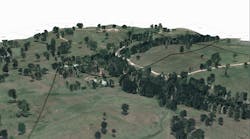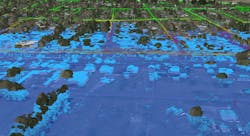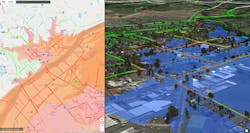Extreme weather events such as hurricanes are increasing in size and number. The record-breaking 2020 and 2021 hurricane seasons brought power outages with nearly every storm. In 2017, Hurricane Harvey brought wind speeds of more than 130 mph (209 kmph) and catastrophic flooding that damaged thousands of distribution poles and hundreds of transmission structures. In total, 21.4 GW of generation was impacted by wind damage, flooding damage, fuel supply issues, and evacuations and shutdowns during Hurricane Harvey.
In addition to causing major interruptions for utilities and their customers, Hurricane Harvey and other powerful storms rack up major costs. According to the National Oceanic and Atmospheric Administration’s Office for Coastal Management, the total cost for all weather disasters in the last five years was US$ 742.1 billion, more than one-third of the total disaster cost in the last 42 years — US$ 2.155 trillion.
While electric utilities and energy companies may acknowledge the risk of severe weather incidents like hurricanes, many are ill prepared to manage the damage extreme weather inflicts. However, with the right technologies and 3-D modeling, utilities can bolster their hurricane preparation efforts and improve their chances of faster reaction and restoration. Before taking a deep dive into digital solutions, it is important to consider current gaps in today’s technologies.
Digital Challenges
Digital transformation has brought a wave of innovative, impactful solutions to utilities in recent years. Increasingly savvy utilities are using predictive technology to anticipate weather patterns that threaten to disrupt utility operations. With this new technology, one would expect a reduction in blackouts and improved restoration speeds in response to storms. However, that is not always the case.
The 3-D modeling technologies known as digital twins — and there are different types of digital twins — can provide a real-world representation of a network while geographic information systems (GIS) can create digital maps of surrounding environments based on spatial data. However, where these technologies fall short is determining how specific assets will behave during a storm. For instance, today’s systems can model how power lines and even conductors will behave during a hurricane. However, many types of digital twins and GIS in general cannot perform the granular analysis to see how specific assets, for example poles, will react to storms.
This challenge begs the question: If a specific piece of equipment is damaged, will today’s simulations accurately inform how surrounding assets will react? Will there be a large ripple effect that damages other assets (that is, cascading pole failures)? To properly address these types of questions, more sophisticated tools and data analysis are needed.
These new solutions need to be able to understand the engineering and physics relationships of utility infrastructures. They also need to be able to operate at scale, because the location of a problem is not always predictable. They must be performant and provide immediate answers — because outages need to be as short as possible. They also need to be open and accessible to different types of users, internal and external, because immediate access to information for all stakeholders is critical during emergencies.
Advanced Technology
Meteorologically speaking, tremendous innovations and advancements have been made in technologies that forecast weather patterns, which greatly help utilities during major weather events like hurricanes. For instance, Tomorrow.io is a leading weather and climate security platform. This technology assists utilities with energy demand, resource allocation and maintenance, power outage preparation, wind staffing protocol and more. It uses powerful predictive analytics to understand the impact of weather and unlock unique trading opportunities, improve the accuracy of a power load forecast, optimize trading procedures and improve insights of impact based on historical, real-time and forecasted weather.
Like forecasting technologies, improvements also have been made to digital twin technologies. While many digital twins are founded on a depth of asset information, or a connectivity model, utilities are realizing benefits from upgraded twins that model real-world engineering relationships. These platforms use machine learning and artificial intelligence (AI) to facilitate the types of analyses a utility requires — like cost of failure (potential damage to a community) or running weather scenarios — all in one environment. These cloud platforms can scale to cover huge distances and quickly add resources to ensure timely results.
How do they work? A digital twin of a utility’s network is built using AI, machine learning and algorithms. Data also is often not perfect — containing gaps — and, therefore, part of the process includes enriching the data. The digital twin is created based on this process and can run complex engineering analysis based on set standards, such as the National Electrical Safety Code (NESC) and GO95. Utilities then can apply different sets of data and run simulations against it to determine the effects of any event on the grid as well as understand failures.
These advanced digital twins provide utilities a view of the entire network in a physics-enabled environment to see how the network reacts to changing weather and surroundings. Through this, utilities can identify potential problems before an event happens and solve critical issues during a hurricane, and they can do so quickly. These advanced technologies now are performing 360-degree pole loading and identifying asset behavior down to the insulator level as well as other specific assets. This is important as utilities can pinpoint vulnerabilities and, therefore, strengthen critical areas where needed before a storm hits. They also predict ripple effects that downed assets will have on other important assets.
These systems also have better speed, scale and access. Instead of needing several hours to run simulations and look for results, this can now happen in minutes — a huge benefit for utilities, as speed is critical in crisis situations. In addition, because these systems are in the cloud, external users are not bogged down with restrictive access issues. Users also can view entire digital networks all at once instead of in segments like older platforms.
Regarding hurricane and severe storm uses, with these improved technologies, utility operators can identify and address critical issues like floods, from ocean surges and heavy rain, and high winds. Utilities can quickly explore potential solutions, like including third-party attachments on existing assets to stabilize power. Solutions can be applied digitally and tested before applied in the real world, so utilities have confidence in the efficacy of solutions before a storm hits and the challenge arises. This can go a long way in limiting blackouts in the more vulnerable areas as well as speed up power restoration. It is difficult to have this level of impact with older digital twin technologies.
A Case Study
With digital twins, preventive measures can yield tremendous benefits and insights when used to run weather scenarios before they happen to reinforce networks. Another advantage of advanced digital twin technology occurs after a weather event. Once a storm clears, utilities have to deal with the aftermath by analyzing the damage to see how best to restore power to areas most severely impacted. The following case study touches on this situation and how a leading Australian utility used digital twin solutions from Neara, a global software-as-a-service company that provides a physics-enabled platform that builds 3-D interactive models of critical infrastructure networks and assets, in a large-scale flooding crisis.
Last March, parts of Greater Western Sydney were inundated by 1-in-50-year floods, resulting in customer outages and damage to power infrastructure across the network of Endeavour Energy, one of the top-performing Australian utilities with a coverage area of 9653 sq miles (25,001 sq km).
Endeavour Energy faced significant outages and asset damage across its network. The utility already was using Neara’s design tools to accelerate its design process. When the flood emergency occurred, the utiity approached Neara for an urgent and immediate solution to be able to understand the effect of the floods on its network. Neara implemented a variety of flood-mapping tools, which included a floodwater simulator with user-defined water depth that could be applied across the network; output reports for floodwater-height per pole and span-submersion events; and polygon layers for expected flood areas from open-source government data.
Network-wide reports on flood activity were visible and editable in Neara’s applications within 48 hours of the emergency commencing — as floodwaters were still rising. The utility actively used the flood-mapping features to assist in power restoration to customers. The reports helped the utility to prioritize pole inspections and understand possible hazards before going to a site. The utility was able to effectively target the right areas for fixing and speed up the power restoration process for residents who sorely needed the power.
The Future of Digital Twins
The benefits of digital twins are endless, and utilities will need to continue seeking new ways of combating challenging situations in their network that cause severe outages and disruptions as well as billions of dollars in damage. Severe weather activity is only going to worsen. Utilities must keep pace by investing in technology that will help them with the biggest of crises. The better tools they are equipped with, the better they can serve customers.
Robert Brook is senior vice president and general manager of the Americas at Neara. He has spent more than 30 years in the energy and information technology industries and is a recognized expert in the development and implementation of technology for infrastructure and asset management as well as risk mitigation. He previously has filled key industry positions, including president of Hecatic Labs, senior director of business technology at Pacific Gas and Electric Co. and global utility industry manager at Esri.
About the Author
Robert Brook
Robert Brook is SVP and GM Americas at Neara and has spent more than 30 years in the energy and information technology industries and is a recognized expert in the development and implementation of technology for infrastructure and asset management as well as risk mitigation. He previously has filled key industry positions, including president of Hecatic Labs, senior director of business technology at Pacific Gas and Electric Co., and global utility industry manager at Esri.



